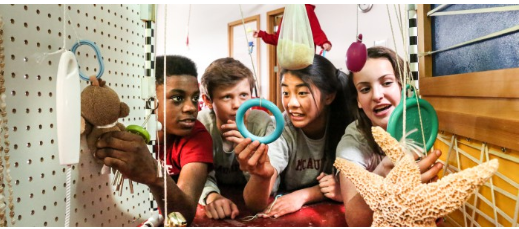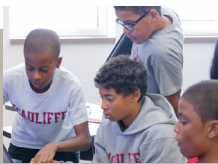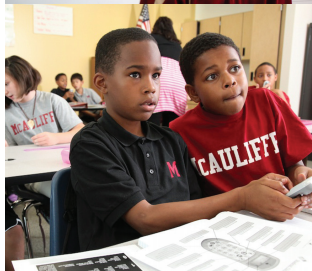07.29.19‘The Moments When They Come To See What We Really Think’: A Guest Post from Jennifer Snodgrass

Jennifer Snodgrass is Director of Achievement at McAuliffe International School, an IB school within Denver Public Schools that works to offer the most rigorous learning environment possible. I first met Jennifer when she agreed to pilot and give us feedback on our knowledge-based Reading Curriculum. Her feedback was consistently wise and insightful and so when she recently told me about how she and some colleagues were working to make the connection between high expectations and relationship building more explicit, I asked if she’d be interested in writing about it here. She writes:
At McAuliffe International School, a middle school in Denver, we have worked very hard over the past several years to make high quality curriculum and strong, high-ratio instruction the norm in our classrooms, and after some reflection, we determined that our current area of growth is high expectations.

I know our teachers believe our students are capable of reaching the highest standards. But believing and showing them that we know they are capable of it in our actions, every day… those are different things.
I found myself wondering how we could make high expectations practice-able and observable so that we could give teachers tangible strategies to communicate, through actions, that we believe EVERY student is capable? That EVERY student can and must learn every day?
To accomplish this, I’ve come to believe in the idea of “nudges”– according to Richard Thaler, a targeted intervention that makes doing the wrong thing harder than doing the right thing. In a school setting, this means creating situations where not trying and doing nothing (opting out) is not an option. We must make it easy for a student to choose to do the right thing and we’ve decided to develop our teachers’ capacity to nudge students in the right direction through every interaction.
My mantra has become: Nudge every student every day. Student responses give us data, and we need to develop teachers’ capacity to react to that data in the moment with a nudge that gives the student what he or she needs to get better.
To make it simpler to think about responses as data I encourage teachers to put student responses into one of four categories, each of which we can also think about in terms of what it suggests a student needs at that moment:
| Category | Need | Nudge |
| No Answer: Student fear of failure or unwillingness to try… often “I don’t know” | student needs to know she can do the work, is an important member of the community and to not be rewarded for non-participation | No Opt Out |
| Wrong Answer: Lack of basic student understanding… Student gives an answer that is clearly wrong | student needs instruction broken down but not watered down. They need to experience success but not a reduction in rigor. To have the right answer made comprehensible | Break It Down |
| Partial Answer: Student expresses understanding but has not captured the full idea or pushed her thinking sufficiently. | student needs to know that we know he is capable of great, not just ok or almost great and needs to experience herself giving a better answer | Right is Right |
| Correct answer: The answer is exemplary and shows mastery and insight. But this raises the question of what happens next. | student needs–deserves–to be pushed to know that learning doesn’t end with “right” — that we care enough to push him to answer with ever-increasing levels of precision and perception. | Stretch It |
It’s the middle column above that I think is so important. Our responses to students give them data, too, about how we view them and about our expectations. These are the moments when they come to see what we really think of them and their capacity.

At McAuliffe we are developing training to focus on teacher behaviors that communicate high expectations, with practice sessions to build capacity with No Opt Out, Break it Down, Right is Right, and Stretch It questioning techniques.
Last summer, I was greatly influenced by a series of blog posts by Dan Cotton about Relationships through Competence. The idea is that young people thrive when they feel safe, successful, and known. At McAuliffe, we believe in particular, that success builds trust and intrinsic motivation for students and so we see the above work as being about relationship building with our students- something that might not seem obvious at first. Our hope is to be systematic about how we make students feel via these “nudges” and that this will serve as the building blocks of productive, trusting relationships between teachers and students- every student, every day.
We are going to start by deep-diving No Opt Out because analysis of data and feedback from staff tell us our teachers want tools to engage resistant students productively from the very start. McAuliffe is a large, urban school in Denver serving a wide range of students from over 30 elementary schools.
This past spring, our instructional leadership team spent some time analyzing longitudinal data on students who didn’t grow at least one performance band in language arts during their three years with us. These students had given us their time, but we had not made them ready for high school. It was not a long list of names, but these are the kids who keep us up at night, and my principal has made it a priority to tailor and intensify supports for these most vulnerable students. After lots of thinking and conversation, we determined that our biggest mistake with these students is that we had allowed them to opt out. Heading into this year, we feel a special sense of urgency to make sure ALL students see themselves as members of our learning community.

We wonder: what will happen if, as a school, in every classroom, starting on the first day of sixth grade, these vulnerable students receive the message that their participation is expected and needed? That it’s ok to make a mistake and we will help them get the answer? That they are members of the classroom community — just as important as everyone else?
This messaging will start with a teacher requiring them to at least repeat the correct answer of a classmate; next, they will answer a Break it Down question with the help of cues, and hopefully, before long, they will be giving all the way right answers and extending their thinking by providing evidence from the text and making connections between sections of text. Can we make it happen? Our school has a staff of incredibly smart and hard-working teachers who year after year inspire incredible growth in students. Many of our teachers are already doing this with exceptional results, and they are the ones who have shown us the power of these moves.
But we will not forget our proficient and advanced learners. I strongly believe that we should not have to choose between closing the gap and lifting the tide, and responding to those almost right or right answers with a nudge also feels critically important.